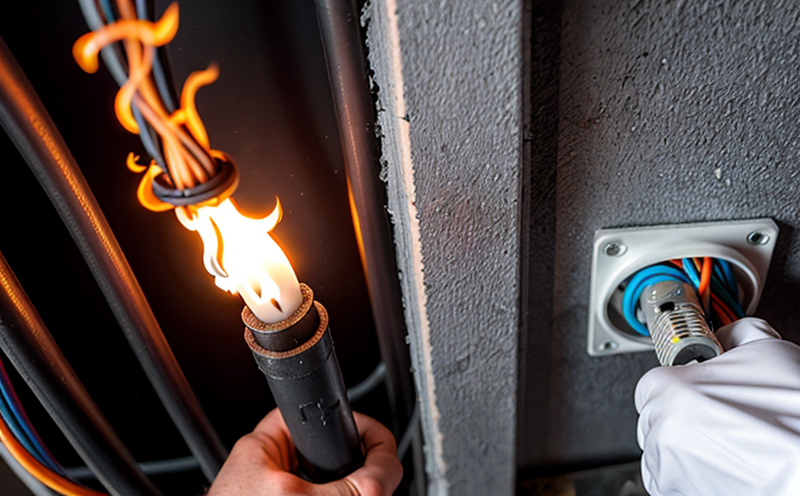ISO 6722 Flammability Testing of Automotive Wires
The ISO 6722 flammability test is a critical procedure used to evaluate the fire resistance properties of automotive wires and cables. This testing ensures that materials meet stringent safety standards, particularly in environments where electrical components are exposed to potential ignition sources. The primary objective of this test is to assess how well the material resists burning under controlled conditions.
During the ISO 6722 flammability test, a specimen is subjected to an open flame for a specified duration. Observers then measure various parameters such as the time it takes for ignition to occur and the duration of burning. The testing can be performed on both insulated wires and bare conductors, depending on the application.
The standard specifies that specimens should have a minimum length of 100 mm with a cross-sectional area ranging from 0.5 mm² to 2.5 mm². This ensures consistent results across different types of automotive wiring systems. For more complex assemblies like harnesses or bundled wires, separate tests may be required.
The testing process is conducted under defined environmental conditions, including temperature and humidity levels that simulate real-world scenarios. Compliance with these parameters guarantees accurate and repeatable test outcomes.
Understanding the fire resistance characteristics of automotive wiring is crucial for preventing electrical fires in vehicles. These incidents can lead to severe accidents, injuries, or even fatalities. By adhering to ISO 6722 standards, manufacturers ensure that their products contribute positively to vehicle safety.
In addition to assessing basic flammability, this test also evaluates the smoke and toxic gas emissions produced during burning. This information helps engineers design better fire protection systems within vehicles, thereby enhancing overall safety performance.
ISO 6722 testing plays a vital role in regulatory compliance for manufacturers who produce automotive components. Meeting these requirements demonstrates commitment to quality control and consumer safety. It also facilitates market access by ensuring that products meet international standards recognized worldwide.
The results of ISO 6722 tests provide valuable insights into the fire resistance properties of various materials used in automotive wiring systems. This knowledge enables manufacturers to make informed decisions about selecting appropriate materials for specific applications, ultimately leading to safer vehicles on roads everywhere.
Given its importance in ensuring vehicle safety and regulatory compliance, many organizations rely on specialized laboratories equipped with state-of-the-art facilities capable of performing ISO 6722 tests accurately. These labs employ experienced technical staff proficient in handling all aspects of the testing process from specimen preparation to final analysis.
- Specimen Preparation: Ensuring that specimens meet the specified dimensions and material types is essential for obtaining reliable results.
- Environmental Control: Maintaining consistent temperature, humidity, and ventilation conditions throughout the test enhances accuracy.
- Instrumentation & Equipment: Utilizing advanced equipment like calorimeters allows for precise measurement of heat release rates and other relevant metrics.
- Data Analysis: Skilled analysts interpret collected data to determine whether specimens comply with ISO 6722 criteria.
By incorporating rigorous quality assurance measures, laboratories can ensure the integrity of test results. This approach not only satisfies regulatory requirements but also builds trust among stakeholders including consumers and regulators.
The ISO 6722 flammability test is an indispensable tool for assessing the fire resistance properties of automotive wires and cables. Its application in real-world scenarios highlights its significance in enhancing vehicle safety while ensuring compliance with international standards.
Why It Matters
The ISO 6722 flammability test is essential because it helps identify potential fire hazards associated with automotive wiring systems early on in the development process. By detecting issues before mass production begins, manufacturers can address them promptly and avoid costly recalls later.
This testing also contributes to improving overall vehicle safety by reducing the risk of electrical fires caused by faulty or substandard wires. Such incidents could otherwise lead to serious accidents resulting in injuries or fatalities.
Compliance with ISO 6722 standards is required for many countries around the world, making it a crucial aspect of global automotive manufacturing practices. Adhering to these regulations helps manufacturers maintain their reputation and ensure they meet international safety standards.
The test results provide valuable information that can guide future improvements in wire design and selection processes. Engineers use this data to refine materials and techniques used in manufacturing, ultimately resulting in safer vehicles for consumers.
Why Choose This Test
Choosing ISO 6722 flammability testing offers several advantages over other methods available today. Firstly, it provides a standardized approach that ensures consistent results across different laboratories and regions worldwide. Secondly, the test covers multiple aspects of wire performance beyond just flame resistance, including smoke generation and toxic gas emissions.
Another advantage is its relevance to real-world driving conditions. The testing simulates various environments where automotive wiring might be exposed to fire risks, such as under-the-hood areas or passenger compartments. This ensures that the results accurately reflect actual field performance.
Moreover, ISO 6722 tests are conducted in controlled laboratory settings that closely mimic real-life scenarios. This allows for precise measurement and analysis of key parameters influencing wire behavior during a fire event.
The test also supports regulatory compliance efforts by providing data needed to meet strict international standards set forth by organizations like the International Organization for Standardization (ISO).
Finally, choosing ISO 6722 flammability testing demonstrates a manufacturer's commitment to quality and safety. It showcases their dedication to producing reliable products that contribute positively towards enhancing vehicle safety.





